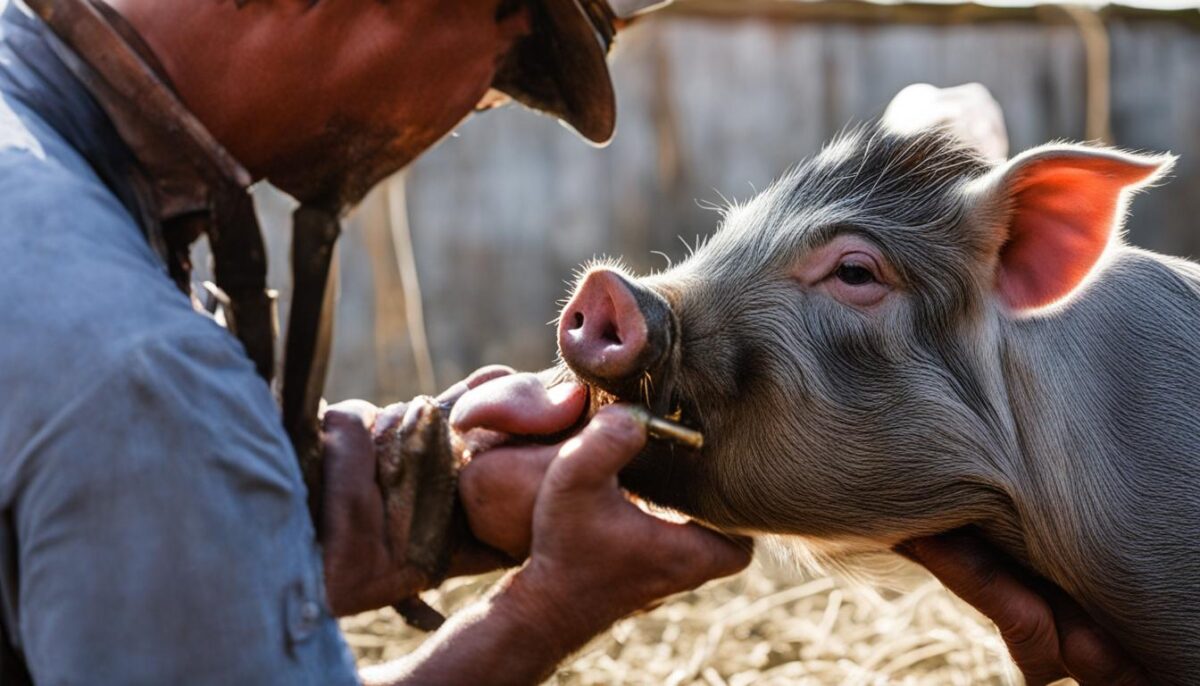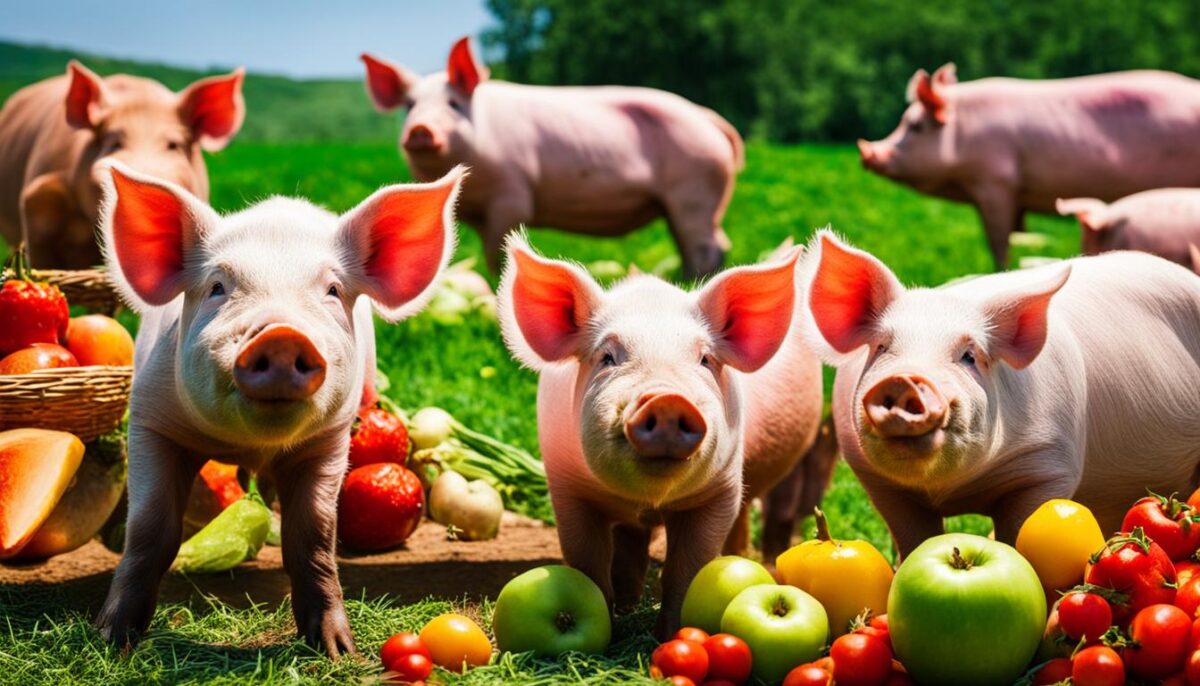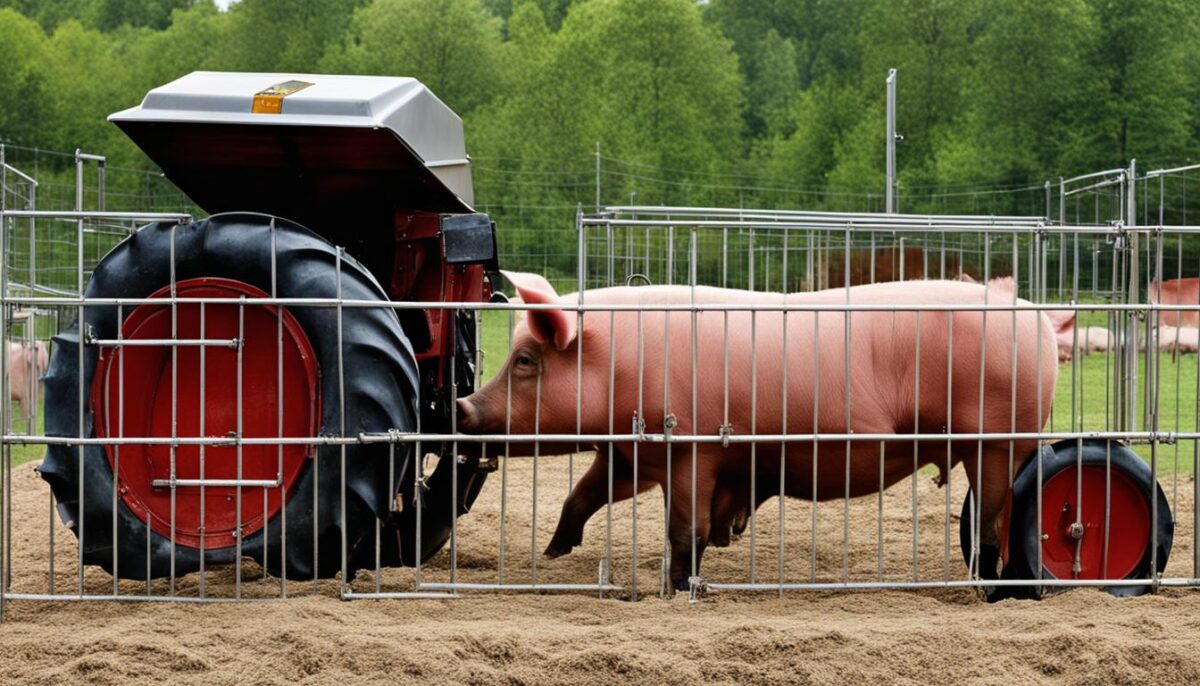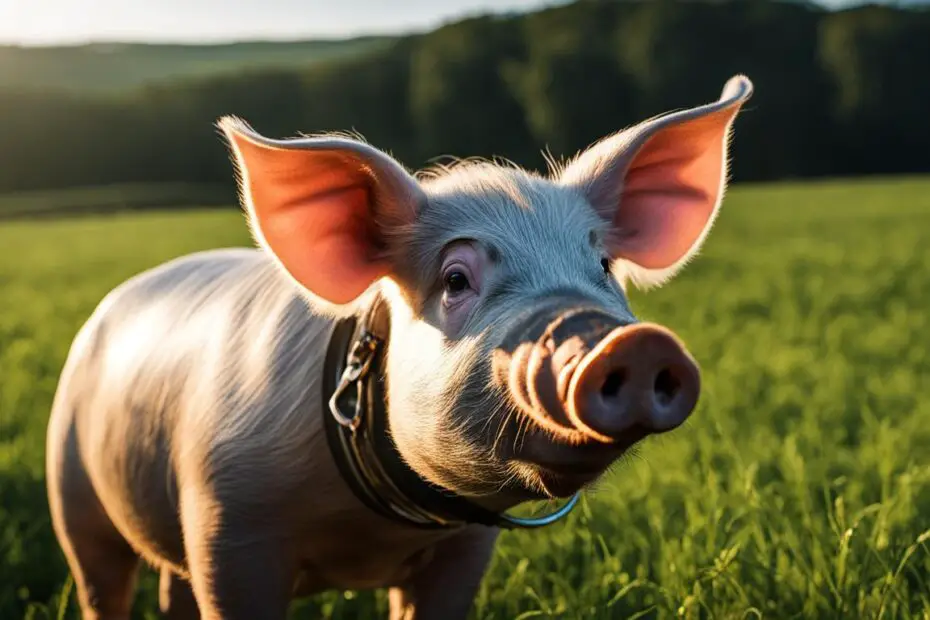Nose rings are a vital tool in preventing the destructive behavior of rooting in pigs. By using a pig nose ring, farmers can effectively deter pigs from digging in the ground in search of food, protecting their land and fences. This method is considered essential for rooting prevention in pigs, providing a humane solution to control their behavior.
Key Takeaways:
- A pig nose ring is a solution to stop rooting behavior in pigs.
- Rooting can cause damage to land and fencing.
- The nose ring creates discomfort for pigs, discouraging them from rooting.
- Using a pig nose ring is considered an essential solution for preventing rooting in pigs.
- Pig nose rings allow pigs to maintain their natural instincts while preventing destructive behaviors.
Understanding the Purpose of Nose Rings for Pigs
Nose rings serve a specific purpose in addressing the issue of rooting in pigs. Rooting, a natural behavior for pigs, can lead to destructive consequences if not controlled. The nose ring is designed to create discomfort for the pig when attempting to root, thereby discouraging this behavior. By preventing rooting, nose rings protect the land, fences, and other structures in the pig’s environment.
The primary purpose of nose rings is to prevent pigs from engaging in rooting, which involves using their snouts to dig in the ground in search of food. This behavior can be detrimental to both the pig and its surroundings. Nose rings apply pressure against the pig’s skin when they try to root, causing discomfort that discourages the behavior. The discomfort serves as a deterrent, prompting the pig to learn alternative behaviors that are less destructive.
“Nose rings create discomfort for pigs when rooting, helping to deter the behavior and prevent damage to the environment.”
Nose rings are particularly effective in tough ground conditions, where rooting can cause significant damage. The discomfort caused by the nose ring makes rooting painful for the pig, rendering it undesirable. However, it is important to note that nose rings still allow pigs to engage in rooting behavior in loosely-packed piles of vegetation, where the discomfort is minimal. This ensures that the pigs can exhibit their natural behaviors to some extent while minimizing the potential for damage.
| Type of Behavior | Effect of Nose Rings |
|---|---|
| Rooting | Discouraged and minimized |
| Ground Damage | Prevented |
| Vegetation foraging | Allowed in loosely-packed piles |
How Nose Rings Work to Stop Pigs From Rooting
Nose rings are an effective tool for preventing pigs from engaging in the destructive behavior of rooting. When a pig wears a nose ring, the ring applies pressure against the pig’s skin when they attempt to root, causing discomfort. This discomfort serves as a deterrent, discouraging the pig from continuing the rooting behavior.
The pressure exerted by the nose ring makes rooting painful for the pig, especially in tough ground where the pig’s snout meets resistance. The discomfort associated with rooting in these conditions makes it undesirable for the pig, effectively stopping the behavior. However, it’s important to note that nose rings still allow pigs to root in loosely-packed piles of vegetation, where the discomfort is minimal.
The mechanism behind how nose rings work is simple yet effective. By utilizing discomfort as a means of discouragement, nose rings offer a humane solution to prevent pigs from damaging land, fences, and other structures in their environment. This method ensures the well-being of both the pigs and their surroundings.
To understand the effectiveness of nose rings in stopping rooting behavior, let’s take a look at the following table:
| Rooting Behavior | Effect of Nose Ring |
|---|---|
| Pig attempts to root in tough ground | Pressure from nose ring causes discomfort, discouraging further rooting |
| Pig attempts to root in loose vegetation | Minimal discomfort from nose ring, allowing pig to root without significant deterrent |
The table clearly demonstrates that nose rings effectively stop pigs from engaging in destructive rooting behavior in tough ground, while still allowing them to exhibit their natural instincts in more forgiving environments. This balance promotes appropriate behavior while minimizing damage to the pig’s surroundings, making nose rings a valuable tool for pig farmers.
Putting a Nose Ring on a Pig: Procedure and Considerations
Putting a nose ring on a pig is a process that requires care and proper technique. It is recommended that a veterinarian perform the procedure, but it is possible for owners to ring pigs themselves. The use of nose ring pliers is essential for accurately positioning the ring on the pig’s nose.
When putting a nose ring on a pig, one person should gently restrain the pig and hold its head steady, while the other person carefully uses the nose ring pliers to position the ring on the top of the pig’s nose. It is crucial to note that the ring should be placed on the outside of the nose, not going through the cartilage that separates the nostrils. This ensures that the pig is not harmed during the process.
While the procedure itself may seem straightforward, it is important to emphasize the significance of proper technique and precision. Having a skilled professional, such as a veterinarian, perform the procedure can minimize the risk of potential injuries to the pig and ensure that the nose ring is placed correctly.
Considerations when Putting a Nose Ring on a Pig
When putting a nose ring on a pig, there are some essential considerations to keep in mind:
- Choose the right size: Nose rings come in different sizes, so it is crucial to select the appropriate size for your pig. A ring that is too tight can cause discomfort and restrict breathing, while a ring that is too loose may not effectively discourage rooting behavior.
- Use proper technique: Whether you are performing the procedure yourself or relying on a professional, it is crucial to use the correct technique. This includes ensuring that the ring is positioned on the outer part of the pig’s nose and not through the cartilage.
- Maintain good hygiene: Before and after putting a nose ring on a pig, it is important to maintain good hygiene practices. This includes sterilizing the equipment and keeping the pig’s surroundings clean to prevent infections.
Table: Comparison of Nose Ring Sizes
| Size | Diameter (in inches) | Recommended Pig Weight (in pounds) |
|---|---|---|
| Small | 0.5 | Under 100 |
| Medium | 0.75 | 100-200 |
| Large | 1 | Over 200 |

Putting a nose ring on a pig requires precision and careful technique to ensure the pig’s well-being and the effectiveness of the ring in discouraging rooting behavior. Proper sizing of the nose ring, correct positioning on the pig’s nose, and maintaining good hygiene are all crucial aspects to consider. Consulting with a veterinarian or an experienced professional can provide valuable guidance and minimize the risk of complications. By following these considerations, pig owners can effectively use nose rings to control rooting behavior while prioritizing the welfare of their animals.
The Debate on the Humane Aspects of Pig Nose Rings
There is ongoing debate among pig owners regarding the humanity and necessity of using nose rings. Some argue that nose rings cause discomfort and therefore should not be used, while others claim that the discomfort is minimal and the pigs quickly learn to avoid the associated pain. The use of pig nose rings raises ethical questions about the welfare of the animals and the impact on their natural behavior.
Proponents of nose rings argue that the discomfort caused by the rings is necessary to prevent destructive rooting behavior, which can lead to damage to the land and fencing. They claim that pigs quickly adapt to the discomfort and stop rooting, resulting in improved land preservation. They also argue that without nose rings, other methods such as physical barriers or chemical deterrents may be less effective or more invasive for the animal.
Opponents of nose rings believe that any form of discomfort or pain inflicted on animals is unethical. They argue that pigs have a natural inclination to root and that restraining this behavior through nose rings goes against their natural instincts. They advocate for alternative methods of rooting prevention, such as providing pigs with suitable environments that satisfy their natural behavior needs while minimizing the risk of damage to the surroundings.
| Pros of Pig Nose Rings | Cons of Pig Nose Rings |
|---|---|
| Effectively prevents destructive rooting behavior | Restrains natural behavior and instincts of the pigs |
| Preserves the integrity of the land and fencing | Raises ethical concerns about animal welfare |
| Less invasive compared to other methods | May cause discomfort and pain to the pigs |
“The use of pig nose rings raises ethical questions about the welfare of the animals and the impact on their natural behavior.”
In conclusion, the debate on the humane aspects of pig nose rings revolves around the effectiveness of rooting prevention versus the ethical concerns of causing discomfort to the animals. It is important for pig owners to consider the welfare of their animals and make an informed decision based on their individual circumstances. Striking a balance between the pigs’ natural behavior and the preservation of the land is crucial for sustainable pig farming practices.
The Importance of Pig Rooting in the Wild and Anemia Prevention
Pig rooting behavior is a natural instinct seen in both wild pigs and those raised on farms. In the wild, pigs root in the soil to find food sources, including iron-rich soil that helps prevent anemia. Anemia is a condition characterized by a deficiency of red blood cells or hemoglobin, which can lead to weakness, fatigue, and other health issues in pigs. Farmers raising pigs in controlled environments must provide alternative sources of iron supplementation to prevent anemia in piglets.
While nose rings are effective in preventing destructive rooting behavior, it is crucial to ensure that pigs receive proper nutrition and iron supplementation for their overall health and wellbeing. In addition to supplementing iron, farmers may provide pigs with specially formulated feed that contains the essential nutrients needed to promote healthy blood cell production and prevent anemia.

In summary, pig rooting behavior serves an important purpose in the wild, allowing pigs to find iron-rich soil and prevent anemia. However, in controlled environments like farms, it is necessary to provide alternative sources of iron supplementation to ensure the health and wellbeing of the pigs. Nose rings are an effective tool for preventing destructive rooting while allowing pigs to root in appropriate environments. By combining proper nutrition and the use of nose rings, pig farmers can promote the overall health, safety, and sustainability of their operations.
The Impact of Rooting on the Environment and Ecosystems
Rooting behavior in feral pigs can have far-reaching impacts on the environment and ecosystems. One of the most significant consequences is soil erosion. When pigs root in the soil, they uproot vegetation and disturb the soil structure, making it more vulnerable to erosion by wind and water. The loss of topsoil can result in nutrient depletion and reduced agricultural productivity.
Another effect of rooting is the reduction of natural cover. Pigs will often remove plants and ground cover while rooting, leaving bare patches of soil exposed. This loss of vegetation disrupts the natural balance of ecosystems, affecting the biodiversity of plant and animal species that rely on the cover for shelter and food.
“The impact of pig rooting on the environment is significant. It disrupts soil structure, leads to erosion, and reduces natural cover for many plant and animal species.” – Dr. Emily Johnson, Environmental Scientist
The feeding habits of feral pigs, enabled by their ability to root, can also contribute to their successful adaptation in new environments. Pigs are opportunistic foragers and will consume a wide range of plants and invertebrates during their rooting activities. This adaptability allows them to thrive in diverse habitats but can also disrupt native ecosystems and outcompete native species for resources.
| Impact of Rooting | Consequences |
|---|---|
| Soil Erosion | Loss of topsoil, nutrient depletion, reduced agricultural productivity |
| Natural Cover Reduction | Disruption of ecosystems, loss of biodiversity, habitat degradation |
| Adaptive Success | Thriving in diverse habitats, outcompeting native species |
Given the detrimental effects of rooting on the environment and ecosystems, it is crucial to implement control measures like nose rings to minimize the negative impacts. By reducing or preventing rooting behavior in domesticated pigs, farmers can help protect the integrity of their land and preserve the natural balance of ecosystems.
The Pig Tractor Solution for Rooting Behavior
One innovative solution that harnesses the natural rooting behavior of pigs is the pig tractor. Unlike traditional methods that aim to completely prevent rooting, the pig tractor utilizes this instinct to plow and fertilize the garden. This portable structure allows farmers to move the pigs to different areas, enabling them to till the land and deposit manure as they root. The pig tractor not only integrates the natural behavior of pigs into a sustainable farming practice but also offers several benefits for both the pigs and the environment.
The pig tractor serves as an efficient way to plow the land, saving farmers time and labor. As the pigs root, they loosen the soil, making it easier for subsequent cultivation. This eliminates the need for costly machinery or manual plowing, reducing expenses and minimizing soil compaction. Additionally, the pig tractor helps to improve soil fertility by naturally incorporating organic matter into the soil. The pigs’ rooting behavior facilitates the breakdown of plant material, releasing essential nutrients and enhancing soil health.
Moreover, the pig tractor provides an environmentally friendly method of fertilizing the garden. As the pigs root, their natural manure is deposited throughout the area. This acts as a natural fertilizer, enriching the soil with nutrients necessary for plant growth. By using the pig tractor, farmers can reduce their reliance on synthetic fertilizers, contributing to a more sustainable and eco-friendly farming practice. Furthermore, the pig tractor helps to minimize waste by utilizing the pigs’ natural behavior to transform their waste into a valuable resource.
| Benefits of the Pig Tractor | Summary |
|---|---|
| Efficient plowing | The pig tractor saves time and labor by utilizing pigs to plow the land. |
| Improved soil fertility | Through their rooting behavior, pigs enhance soil health and nutrient content. |
| Natural fertilization | The pig tractor provides a sustainable method of fertilizing the garden using the pigs’ natural manure. |
| Eco-friendly farming | By reducing reliance on synthetic fertilizers, the pig tractor promotes a more sustainable farming practice. |
Overall, the pig tractor offers a unique and practical solution for managing rooting behavior while capitalizing on the benefits it provides. By incorporating pigs into the plowing and fertilization process, farmers can create a more efficient, sustainable, and environmentally conscious farming system.

Conclusion
In conclusion, using a pig nose ring is an effective and humane solution for controlling rooting behavior in pigs. By applying pressure and causing discomfort, nose rings discourage pigs from engaging in destructive rooting activities while still allowing them to exhibit their natural instincts in appropriate environments.
The benefits of using pig nose rings include protecting the land and fences from damage caused by rooting, thereby ensuring the safety and sustainability of pig farming practices. Nose rings provide a practical tool for farmers to manage their pigs’ behavior without resorting to drastic measures that may compromise the welfare of the animals.
Alternatively, the pig tractor method offers a sustainable approach that harnesses the natural rooting behavior of pigs. By utilizing pigs to plow and fertilize the land, farmers can integrate their natural instincts into farming practices, promoting soil health and sustainable cultivation.
Overall, whether through the use of nose rings or the pig tractor method, pig farmers can effectively control and manage rooting behavior in a manner that aligns with the welfare of their animals and the needs of their farming operations.
FAQ
What is the purpose of using a nose ring on pigs?
Nose rings are used to prevent the rooting behavior in pigs, which can cause damage to land and fencing.
How do nose rings work to stop pigs from rooting?
Nose rings create discomfort for pigs when they attempt to root, discouraging the behavior.
How is a nose ring put on a pig?
Putting a nose ring on a pig requires a two-person process, with one person restraining the pig while the other uses nose ring pliers to position the ring on the top of the pig’s nose.
What is the ongoing debate surrounding the use of pig nose rings?
There is debate regarding the humanity and necessity of using nose rings, with some arguing that they cause discomfort, while others claim the discomfort is minimal and the pigs quickly learn to avoid the associated pain.
Why is pig rooting behavior important in the wild?
Pig rooting is a natural behavior in the wild, allowing pigs to find food sources and prevent anemia through access to iron-rich soil.
What impact does rooting have on the environment and ecosystems?
Rooting behavior can lead to increased soil erosion, disrupt the natural decomposition cycle, and reduce natural cover that promotes plant growth.
What is the pig tractor solution for rooting behavior?
The pig tractor utilizes pig rooting behavior for plowing and fertilizing the garden, allowing farmers to integrate their natural instincts into a sustainable farming practice.


